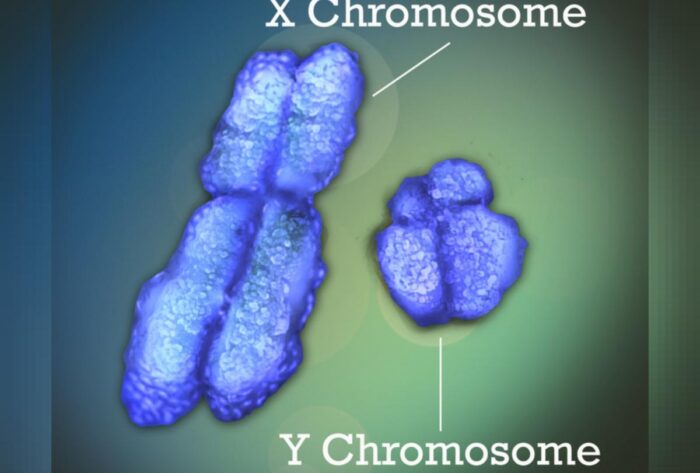The Y chromosome, often associated with masculinity, is revealing an unexpected fragility. Despite harboring the crucial SRY gene that determines male development, it contains very few other genes and is not essential for life—unlike other chromosomes.
While females thrive without a Y chromosome, males possess an X and a diminished Y chromosome. If the current rate of degeneration continues, scientists estimate that the Y chromosome will vanish completely in a mere 4.6 million years. Though this may seem distant, considering Earth’s 3.5 billion-year history, it raises intriguing questions about the fate of men.
The Y chromosome’s history offers fascinating insights. Rewinding 166 million years to the first mammals, the early “proto-Y” chromosome mirrored the X chromosome in both size and gene content. However, the Y chromosome possesses a fundamental flaw.
Unlike other chromosomes that occur in pairs, the Y chromosome is solely inherited from fathers to sons, preventing genetic recombination—gene shuffling that reduces harmful mutations. Consequently, Y chromosomal genes degenerate and eventually vanish from the genome.
Nonetheless, recent research indicates that the Y chromosome has developed mechanisms to slow down gene loss. A Danish study uncovered large-scale structural rearrangements that facilitate “gene amplification,” where genes promoting healthy sperm function acquire multiple copies, mitigating gene loss.
Moreover, the Y chromosome features unique structures called “palindromes,” DNA sequences that read the same forwards and backwards. These palindromic sequences undergo frequent “gene conversion events,” akin to a “copy and paste” process that repairs damaged genes using undamaged copies as templates.
Similar evidence from various species suggests that gene amplification on the Y chromosome is a widespread phenomenon. These amplified genes play critical roles in sperm production and offspring sex ratio regulation.
Yet, the question remains: will the Y chromosome truly vanish? Scientists are divided into two camps—the “leavers” and the “remainers.” The latter argue that the defense mechanisms are effective, rescuing the Y chromosome.
However, the “leavers” contend that these mechanisms merely postpone its eventual demise. Thus, the debate continues.
Jenny Graves, a prominent advocate for the “leave” argument, maintains that, in the long term, Y chromosomes are inevitably doomed, even if they persist longer than anticipated. She points to Japanese spiny rats and mole voles as examples of species that have completely lost their Y chromosomes, suggesting that the loss or creation of genes on the Y chromosome inevitably leads to fertility issues, which can drive the formation of entirely new species.
But what does the potential disappearance of the Y chromosome mean for men?

In our analysis of this subject, we argue that even if the Y chromosome disappears in humans, it does not imply the extinction of males. In species that have lost their Y chromosomes, both males and females remain crucial for reproduction.
The SRY gene, responsible for genetic maleness, relocates to another chromosome, enabling the production of males without a Y chromosome. However, this new sex-determining chromosome would likely undergo degeneration due to the absence of recombination, similar to the doomed Y chromosome.
Interestingly, in humans, while the Y chromosome is necessary for normal reproduction, many of its genes are dispensable when assisted reproduction techniques are employed. This suggests that genetic engineering could potentially substitute for Y chromosome gene functions, allowing same-sex female couples or infertile men to conceive. However, even if this became widespread, it is unlikely that natural reproduction would cease entirely.
In conclusion, while the potential disappearance of the Y chromosome is an intriguing and debated area of genetic research, there is no need for immediate concern. Its fate remains uncertain, and even if it does vanish, men will likely continue to play a role in normal reproduction.
The notion of a “farm animal” system where a select few males father the majority of children is far from reality. Nonetheless, in the next 4.6 million years, humanity will face more pressing concerns than the fate of the Y chromosome.
Boosting Testosterone For Men And Strengthening The Y Chromosome
Testosterone plays a vital role in men’s health, influencing everything from muscle mass and bone density to mood and libido. It’s no wonder that many individuals seek natural methods to enhance testosterone levels.
One promising avenue is the utilization of red light and near infrared light therapy, which has gained popularity in recent years for its potential to stimulate testosterone production and provide numerous other health benefits.
Red light therapy involves exposing the body to low-level red and near infrared light, typically through specialized devices emitting specific wavelengths of light. These wavelengths penetrate the skin and reach the cells, triggering various biological responses.
The application of red and near infrared light has been shown to promote cellular energy production, improve blood flow, reduce inflammation, and enhance overall cellular function.
When it comes to testosterone, research suggests that red light and near infrared light therapy can positively influence its production. Several studies have demonstrated the beneficial effects of light therapy on testosterone levels.
For instance, a study published in the Journal of Clinical Endocrinology & Metabolism found that men who underwent red light therapy experienced a significant increase in testosterone levels compared to those who received a placebo treatment.
Additionally, another study conducted on male rats showed that exposure to near infrared light led to a significant rise in testosterone levels.
The mechanism behind this testosterone-boosting effect involves the stimulation of the testes. Red and near infrared light therapy prompts increased blood flow to the testes, promoting oxygen and nutrient delivery.
This enhanced circulation helps optimize testicular function and supports the production of testosterone. Moreover, light therapy may also influence the hypothalamus and pituitary gland, the control centers of hormone regulation, further contributing to testosterone elevation.
Now that we understand the potential benefits, it’s time to explore a powerful solution: Mito Red Light Therapy devices.
Mito Red Light Therapy is a leading brand that offers high-quality devices designed for home use. These devices emit precise wavelengths of red and near infrared light, optimizing the therapeutic effects on testosterone and overall well-being.
Mito Red Light Therapy devices are easy to use, non-invasive, and provide a convenient way to incorporate light therapy into your daily routine.
Click Here To Purchase Your Own Mito Red Light
To experience the benefits of red light and near infrared light therapy for boosting testosterone, consider investing in a Mito Red Light Therapy device. By incorporating this therapy into your lifestyle, you can enjoy potential benefits such as increased testosterone levels, improved muscle recovery, enhanced mood, and enhanced overall health.





